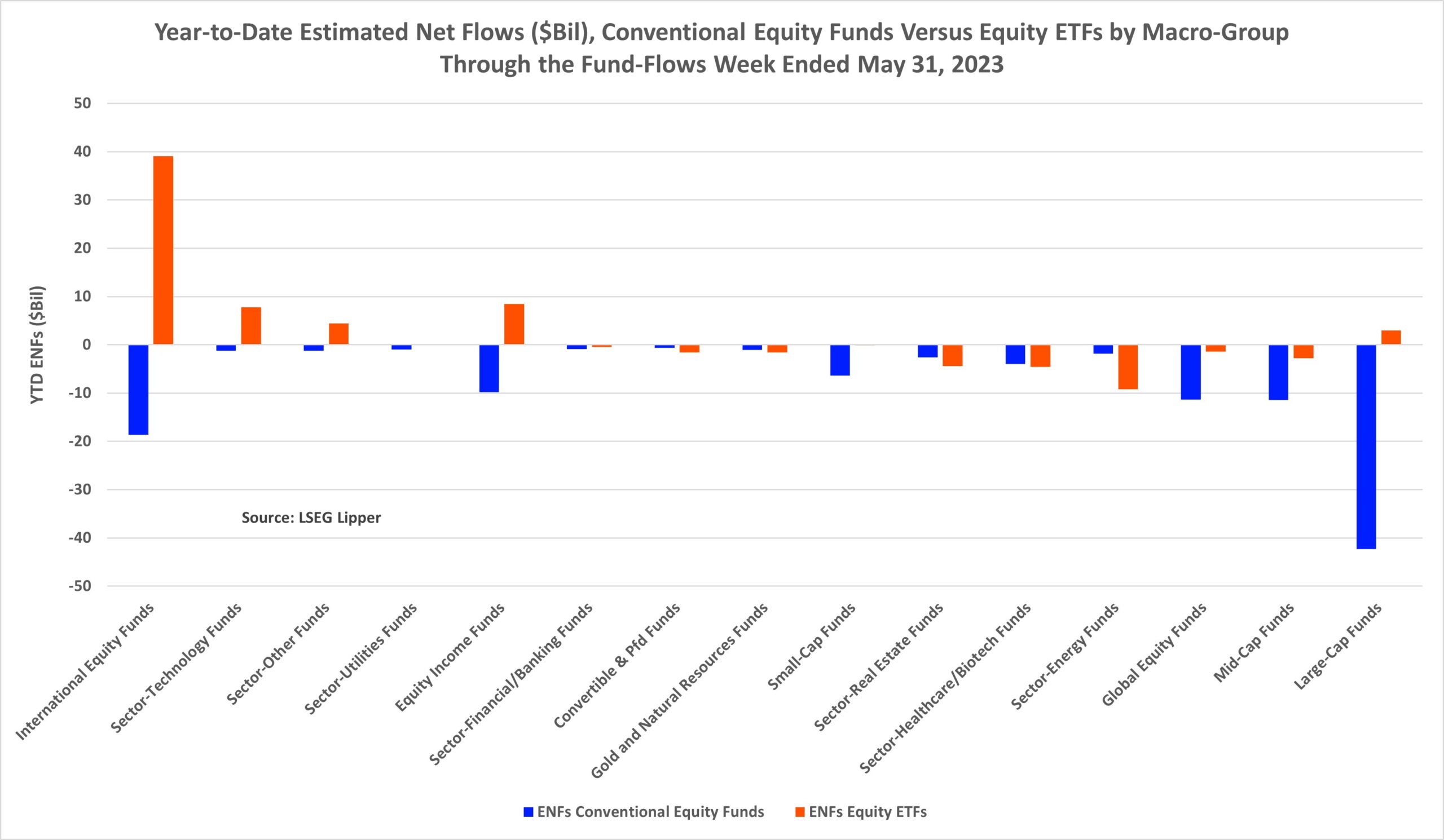During the LSEG Lipper fund-flows week ended May 31, 2023, both the S&P 500 and the Nasdaq Composite finished at their highest levels since August 2022 after Nvidia (NASDAQ:NVDA) beat its Q1 earnings expectations, with the news lifting semiconductor issues and other technology-related companies on the day and as investors embraced reports that suggested Congress was close to a deal to raise the U.S. debt ceiling ahead of the Memorial Day three-day weekend.
The strong surge in mega-cap technology stocks has helped the Nasdaq composite post its strongest fund-flows week return since the week ended February 1. However, a continuation of the debt ceiling standoff, stubborn inflation, and rising interest rates continued to weigh on market participants and narrowed the leaderboard of top-performing U.S. stocks and sectors.
Of the often-followed U.S. indexes, the Nasdaq has been the rockstar of the group, posting an eye-popping 23.59% return year to date, while the S&P 500 returned 8.86% and the Dow Jones Industrial Average lost 0.72% for the same period.
The preliminary flows figures through the first five months of the year show that equity funds (including ETFs) have handed back a net $77.5 billion. At the same time—despite rising interest rates—inflation remains stubbornly high, and questions persist on whether the Federal Reserve is done with its tightening campaign, taxable fixed-income funds have taken in $63.0 billion. That said, municipal bond funds have handed back some $926 million year to date as investors wait cautiously to determine if the rising inflation and the possibility of recession might impact local municipalities’ ability to service their debt.
There appears to be a lot of pent-up demand sitting on the sidelines, with money market funds attracting the largest flows of net new money so far this year of the major asset classes, taking in $495.6 billion, their largest net inflows of any full year since 2020.
On the equity side, investors embraced some of the deeply out-of-favor macro-classifications of 2022, injecting the largest amount of net new money so far this year into international funds (+$20.5 billion, including conventional funds and ETFs), followed by sector-technology funds (+$6.6 billion) and the commodity and materials heavy sector-other funds (+$3.2 billion) macro-classifications. At the other end of the spectrum, investors gave the cold shoulder to large-cap funds (-$39.4 billion), mid-cap funds (-$14.2 billion), and global equity funds (-$12.7 billion).

The dichotomy between conventional equity fund flows and equity ETF flows continues, with equity ETFs attracting a net $36.8 billion year to date, while their conventional funds' counterparts handed back $114.3 billion, with none of the macro-groups attracting net new money year to date.
Drilling down into Lipper U.S. classifications, ETF investors injected the largest amount of net new money into Options Arbitrage/Option Strategies ETFs (+$13.1 billion), European Region ETFs (+$9.7 billion), and International Multi-Cap Core ETFs (+$9.6 billion), with technology, growth-oriented, and dedicate short-bias ETFs jumping into the 10-top list. For the YTD period, ETF investors turned their collective backs on Natural Resources ETFs (-$8.5 billion), Multi-Cap Value ETFs (-$7.9 billion), and Large-Cap Value ETFs (-$6.0 billion).

For the year-to-date period, equity ETF investors injected the largest amount of net new money into iShares MSCI USA Quality Factor ETF (NYSE:QUAL) (QUAL, +$9.9 billion), followed by Vanguard S&P 500 ETF (NYSE:VOO) (VOO, +$9.7 billion), JPM Equity Premium Income ETF (NYSE:JEPI) (JEPI, +$8.9 billion), Vanguard Information Technology Index Fund ETF Shares (NYSE:VGT) (VGT, +$5.9 billion), Vanguard Total Stock Market Index Fund ETF Shares (NYSE:VTI) (VTI, +$5.9 billion), and BetaBuilders Europe ETF (NYSE:BBEU) (BBEU, +$5.7 billion). At the other end of the spectrum, iShares ESG Aware MSCI USA ETF (NASDAQ:ESGU) (ESGU, -$7.7 billion) suffered the largest net redemptions in the equity universe, bettered by iShares Core S&P 500 ETF (NYSE:IVV) (IVV, -$5.5 billion) and iShares Russell 1000 Value ETF (NYSE:IWD) (IWD, -$5.3 billion).
While we are not out of the woods yet, with just two days to spare, investors can finally cross off one of the more pressing issues from their list of worries after President Joe Biden signed the bipartisan debt ceiling bill on Saturday, June 3. Now all eyes will be on the Fed’s upcoming FOMC policy-setting meeting to see if it will skip an interest rate hike in June to better assess the state of the economy—which, if it does, could help expand the performance leadership in the U.S. stock market.
